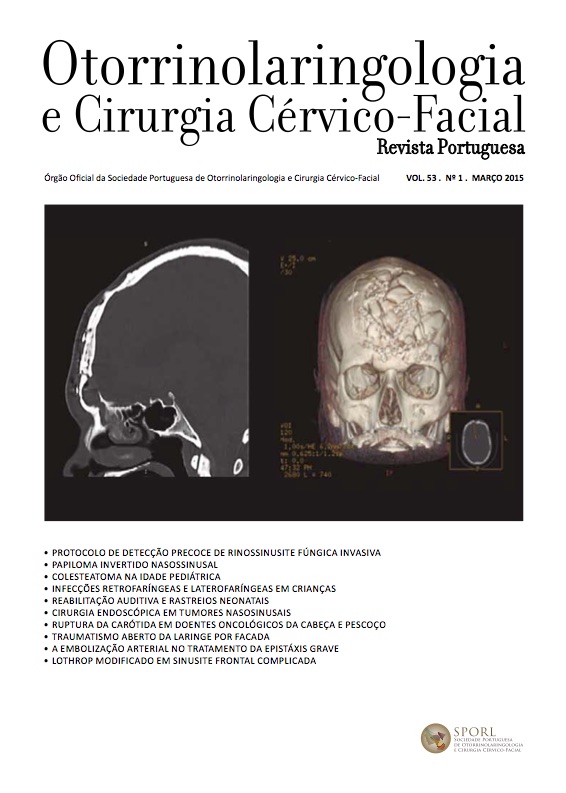Role of neonatal hearing screening programme in the auditory rehabilitation of children
DOI:
https://doi.org/10.34631/sporl.559Keywords:
Deafness, hearing screening, auditory rehabilitationAbstract
Objectives: To determine the influence of the implementation of universal newborn hearing screening programs in the referral to an auditory rehabilitation clinic.
Methods: Setting – auditory rehabilitation clinic in a tertiary referral centre in Lisbon. Study design – observational, retrospective cohort study based on patient clinical records. Population – all records of children born 1998 and after (437 in total) were analysed and 322 meeting inclusion criteria were selected.
Results: Mean age of referral to our clinic has steadily declined from 55 months (1998-2000) to 12 months (2007-2009). About 3/4 of patients are referred due to hearing loss or neonatal screening results.
Conclusion: The neonatal universal screening program has allowed earlier referral of hearing impaired children to an auditory rehabilitation clinic. It’s important to keep those programs running to ensure the early rehabilitation of these children.
Downloads
References
Vaz R, Spratley J, Silva JS, Falcão A, et al. Rastreio auditivo neonatal universal no Hospital de S. João: resultados dos primeiros 12 meses. Rev Portuguesa ORL. 2010;48(4):207-10.
Tasci Y, Muderris, II, Erkaya S, Altinbas S, et al. Newborn hearing screening programme outcomes in a research hospital from Turkey. Child Care Health Dev. 2010;36(3):317-22. Epub 2009/12/18.
Reyes R. Early intervention for hearing impairment: appropriate, accessible and affordable. Ann Acad Med Singapore. 2008;37(12
Suppl):55-2. Epub 2008/12/01.
Benito Orejas JI, Ramirez Cano B, Morais Perez D, Fernandez-Calvo JL, et al. [Results of applying a universal protocol for early detection of hypoacusia in newborn infants for 42 months]. Acta Otorrinolaringol Esp. 2008;59(3):96-101. Epub 2008/03/28. Resultados de aplicar durante 42 meses un protocolo universal de deteccion e intervencion precoz de la hipoacusia en neonatos.
Snashall SE. Deafness in children. Br J Hosp Med. 1985;33(4):205-9. Epub 1985/04/01.
Vohr B, Topol D, Girard N, St Pierre L, et al. Language outcomes and service provision of preschool children with congenital hearing loss. Early Hum Dev. 2012. Epub 2012/01/24.
Mellon NK, Ouellette M, Greer T, Gates-Ulanet P. Achieving developmental synchrony in young children with hearing loss. Trends
Amplif. 2009;13(4):223-40. Epub 2010/02/13.
Mason JO, McGinnis JM. “Healthy People 2000”: an overview of the national health promotion and disease prevention objectives. Public Health Rep. 1990;105(5):441-6. Epub 1990/09/01.
Weirather YP, Korth N, White KR, Downs D, et al. Cost analysis of TEOAE-based universal newborn hearing screening. J Commun Disord. 1997;30(6):477-92; quiz 92-3. Epub 1997/12/16.
Olusanya BO, Akinyemi OO. Community-based infant hearing screening in a developing country: parental uptake of follow-up
services. BMC Public Health. 2009;9:66. Epub 2009/02/25.
GRISI. Recomendações para o Rastreio Auditivo Neonatal Universal (RANU). Acta Pediatr Port. 2007;38(5):209-14.
Cao-Nguyen MH, Kos MI, Guyot JP. Benefits and costs of universal hearing screening programme. Int J Pediatr Otorhinolaryngol.
;71(10):1591-5. Epub 2007/08/28.
Ciorba A, Hatzopoulos S, Camurri L, Negossi L, et al. Neonatal newborn hearing screening: four years’ experience at Ferrara
University Hospital (CHEAP project): part 1. Acta Otorhinolaryngol Ital. 2007;27(1):10-6. Epub 2007/07/03.
Burke MJ, Shenton RC, Taylor MJ. The economics of screening infants at risk of hearing impairment: an international analysis. Int J Pediatr Otorhinolaryngol. 2012;76(2):212-8. Epub 2011/12/02.
Granell J, Gavilanes J, Herrero J, Sanchez-Jara JL, et al. [Is universal newborn hearing screening more efficient with auditory evoked potentials compared to otoacoustic emissions?]. Acta Otorrinolaringol Esp. 2008;59(4):170-5. Epub 2008/05/02. Cribado universal de la hipoacusia neonatal: ?es mas eficiente con potenciales evocados auditivos que con emisiones otoacusticas?
Tsui PW, McPherson B, Wong EC, Ng IH. Infant hearing screening: effects of timeline. Clin Otolaryngol. 2008;33(2):108-12. Epub
/04/24.
Ciorba A, Hatzopoulos S, Busi M, Guerrini P, et al. The universal newborn hearing screening program at the University Hospital
of Ferrara: focus on costs and software solutions. Int J Pediatr Otorhinolaryngol. 2008;72(6):807-16. Epub 2008/04/09.






